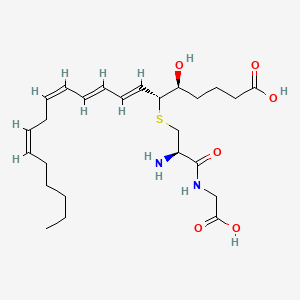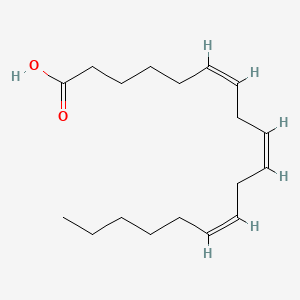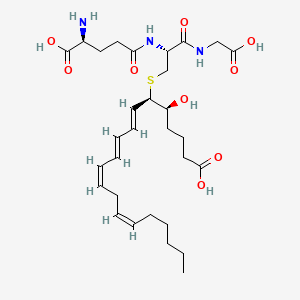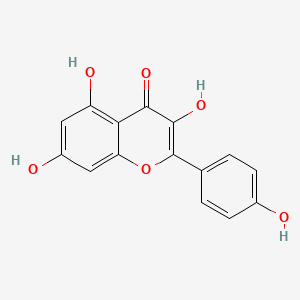
|
LTD4 |
Ltd4 is a lipid of Fatty Acyls (FA) class. Ltd4 is associated with abnormalities such as Inflammatory Bowel Diseases, Inflammatory disorder, Asthma, Pneumonia and Allergic asthma. The involved functions are known as inhibitors, Signal Transduction, Cell Survival, antagonists and Phosphorylation. Ltd4 often locates in Membrane, Tissue membrane, Protoplasm, Cytoplasmic matrix and membrane fraction. The associated genes with LTD4 are ALOX5 gene, UMOD gene, P4HTM gene, RAF1 gene and Homologous Gene. The related lipids are Lipopolysaccharides. |
1167 |

|
gamma-Linolenic acid |
Gamma-linolenic acid is a lipid of Fatty Acyls (FA) class. The involved functions are known as Drug Interactions. Gamma-linolenic acid often locates in Articular system. |
1919 |

|
LTC4 |
Ltc4 is a lipid of Fatty Acyls (FA) class. Ltc4 is associated with abnormalities such as Asthma, Eosinophilia, Pulmonary Eosinophilia, Pneumonia and Cardiovascular Diseases. The involved functions are known as Signal, Gene Expression, Stimulus, Signal Transduction and Metabolic Inhibition. Ltc4 often locates in Plasma membrane, Cytoplasm, Back, Cytoplasmic and Tissue membrane. The associated genes with LTC4 are STIM1 gene, ABCC2 gene, CD9 gene, Mutant Proteins and Amino Acids, Aromatic. The related lipids are glycolithocholate. |
2252 |

|
luteolin |
luteolin is a lipid of Polyketides (PK) class. Luteolin is associated with abnormalities such as Morphologically altered structure, Nodule, retinal toxicity, CLEFT LIP, CONGENITAL HEALED and Ischemia. The involved functions are known as Metabolic Inhibition, Cell Death, Caspase Activation, activation of protein kinase C activity by G-protein coupled receptor protein signaling pathway and protein kinase C activity. Luteolin often locates in Mitochondria, Cell-Free System, Protoplasm, Membrane and Body tissue. The associated genes with luteolin are BCL2 gene, TNFSF10 gene, BCL2L1 gene, XIAP gene and MCL1 gene. The related lipids are Lipopolysaccharides, Sterols, blood lipid, Fatty Acids and Steroids. The related experimental models are Xenograft Model, Mouse Model, Experimental Autoimmune Encephalomyelitis, Knock-out and Cancer Model. |
3284 |

|
kaempferol |
kaempferol is a lipid of Polyketides (PK) class. Kaempferol is associated with abnormalities such as Cardiovascular Diseases, IMMUNE SUPPRESSION, Inflammatory disorder, Dermatitis, Atopic and Asthma. The involved functions are known as enzyme activity, antagonists, DNA Binding, Anabolism and Transcription, Genetic. Kaempferol often locates in aryl hydrocarbon receptor complex, Cytoplasmic matrix, soluble, BL21 and Vacuole. The associated genes with kaempferol are CYP1A1 gene, AHR gene, Genes, Reporter, Candidate Disease Gene and Alleles. The related lipids are Fatty Acids, Steroids, Lipopolysaccharides, Total cholesterol and Palmitates. The related experimental models are Knock-out, Xenograft Model, Breast Cancer Model, Disease model and Animal Disease Models. |
3675 |

|
apigenin |
apigenin is a lipid of Polyketides (PK) class. Apigenin is associated with abnormalities such as Morphologically altered structure, Chimera disorder, Hypertensive disease, infection induced and Infection. The involved functions are known as inhibitors, Gene Expression, Process, Metabolic Inhibition and Cell Death. Apigenin often locates in Vacuole, Cytoplasmic matrix, Cytoplasm, Tissue membrane and Membrane. The associated genes with apigenin are MSMP gene, BCL2 gene, PTGS2 gene, Chromatin and SLC33A1 gene. The related lipids are Lipopolysaccharides, Steroids, 1-Butanol, agosterol A and Butyrates. The related experimental models are Mouse Model, Tissue Model, Knock-out, Xenograft Model and Disease model. |
4250 |

|
quercetin |
quercetin is a lipid of Polyketides (PK) class. Quercetin is associated with abnormalities such as Coronary heart disease, Myocardial Infarction, Cirrhosis, Coronary Arteriosclerosis and Vascular ring. The involved functions are known as Vasodilation, physiological aspects, Fermentation, Process and Ingredient. Quercetin often locates in Arterial system, Endothelium, Skin, Endothelium, Vascular and Tissue specimen. The associated genes with quercetin are P4HTM gene, SULT gene, UGT1A1 gene, ARHGAP26 gene and PLXNB1 gene. The related lipids are blood lipid, Promega, Steroids, Phosphatidylserines and Fatty Acids. The related experimental models are Knock-out, Mouse Model, Xenograft Model, Tissue Model and Cancer Model. |
5377 |

|
Platelet activating factor |
Platelet activating factor is a lipid of Glycerophospholipids (GP) class. Platelet activating factor is associated with abnormalities such as Atherosclerosis, Acute cholecystitis without calculus, Cholecystitis, Colitis and Cholecystitis, Acute. The involved functions are known as Cell Survival, Metabolic Inhibition, lipid oxidation, Apoptosis and Oxidation. Platelet activating factor often locates in soluble, Cellular Membrane, Smooth muscle (tissue), Intima and Tissue specimen. The associated genes with Platelet activating factor are apolipoprotein A-I Milano, Homologous Gene, TSPO gene, HBEGF gene and SLC33A1 gene. The related lipids are Hydroxycholesterols, Liposomes, 25-hydroxycholesterol, Lysophosphatidylcholines and Lipopolysaccharides. The related experimental models are Knock-out, Mouse Model and Transgenic Model. |
7383 |

|
Leukotriene b4 |
Leukotriene b4 is a lipid of Fatty Acyls (FA) class. The involved functions are known as Chemotaxis, release of sequestered calcium ion into cytoplasm and Polymerization. Leukotriene b4 often locates in Protoplasm. The associated genes with Leukotriene b4 are phallacidin. |
9311 |

|
Linoelaidic acid |
Linoelaidic acid is a lipid of Fatty Acyls (FA) class. Linoelaidic acid is associated with abnormalities such as Obesity, Diabetes Mellitus, Non-Insulin-Dependent, Pneumonia, Chronic Obstructive Airway Disease and Metabolic syndrome. The involved functions are known as Metabolic Inhibition, Steroid biosynthesis, Signal Transduction, Insulin Resistance and Inflammation. Linoelaidic acid often locates in Mitochondria, Membrane and Cytoplasmic matrix. The associated genes with Linoelaidic acid are FFAR1 gene, C9orf7 gene, TNF gene, CCL2 gene and TLR4 gene. The related lipids are Fatty Acids, octadecadienoic acid, Steroids, methyl linoleate and Cyanoketone. |
10058 |









